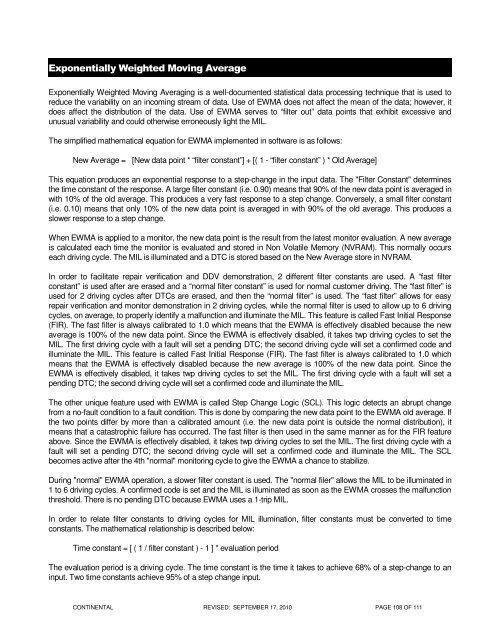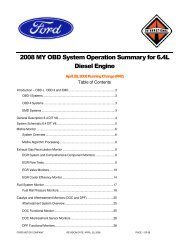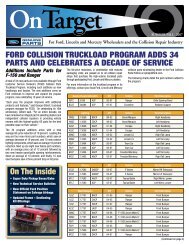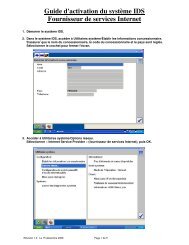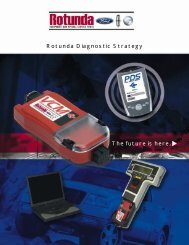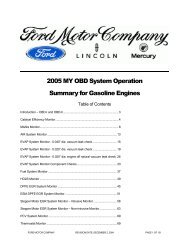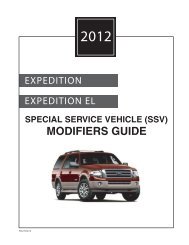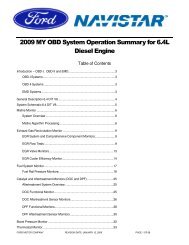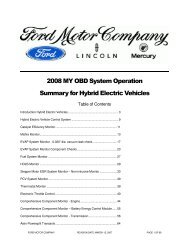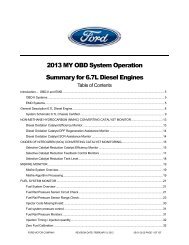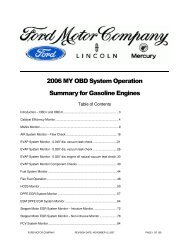OBD Operation Summary for Fiesta - MotorCraftService.com
OBD Operation Summary for Fiesta - MotorCraftService.com
OBD Operation Summary for Fiesta - MotorCraftService.com
- No tags were found...
Create successful ePaper yourself
Turn your PDF publications into a flip-book with our unique Google optimized e-Paper software.
Exponentially Weighted Moving AverageExponentially Weighted Moving Averaging is a well-documented statistical data processing technique that is used toreduce the variability on an in<strong>com</strong>ing stream of data. Use of EWMA does not affect the mean of the data; however, itdoes affect the distribution of the data. Use of EWMA serves to “filter out” data points that exhibit excessive andunusual variability and could otherwise erroneously light the MIL.The simplified mathematical equation <strong>for</strong> EWMA implemented in software is as follows:New Average = [New data point * “filter constant”] + [( 1 - “filter constant” ) * Old Average]This equation produces an exponential response to a step-change in the input data. The "Filter Constant" determinesthe time constant of the response. A large filter constant (i.e. 0.90) means that 90% of the new data point is averaged inwith 10% of the old average. This produces a very fast response to a step change. Conversely, a small filter constant(i.e. 0.10) means that only 10% of the new data point is averaged in with 90% of the old average. This produces aslower response to a step change.When EWMA is applied to a monitor, the new data point is the result from the latest monitor evaluation. A new averageis calculated each time the monitor is evaluated and stored in Non Volatile Memory (NVRAM). This normally occurseach driving cycle. The MIL is illuminated and a DTC is stored based on the New Average store in NVRAM.In order to facilitate repair verification and DDV demonstration, 2 different filter constants are used. A “fast filterconstant” is used after are erased and a “normal filter constant” is used <strong>for</strong> normal customer driving. The “fast filter” isused <strong>for</strong> 2 driving cycles after DTCs are erased, and then the “normal filter” is used. The “fast filter” allows <strong>for</strong> easyrepair verification and monitor demonstration in 2 driving cycles, while the normal filter is used to allow up to 6 drivingcycles, on average, to properly identify a malfunction and illuminate the MIL. This feature is called Fast Initial Response(FIR). The fast filter is always calibrated to 1.0 which means that the EWMA is effectively disabled because the newaverage is 100% of the new data point. Since the EWMA is effectively disabled, it takes twp driving cycles to set theMIL. The first driving cycle with a fault will set a pending DTC; the second driving cycle will set a confirmed code andilluminate the MIL. This feature is called Fast Initial Response (FIR). The fast filter is always calibrated to 1.0 whichmeans that the EWMA is effectively disabled because the new average is 100% of the new data point. Since theEWMA is effectively disabled, it takes twp driving cycles to set the MIL. The first driving cycle with a fault will set apending DTC; the second driving cycle will set a confirmed code and illuminate the MIL.The other unique feature used with EWMA is called Step Change Logic (SCL). This logic detects an abrupt changefrom a no-fault condition to a fault condition. This is done by <strong>com</strong>paring the new data point to the EWMA old average. Ifthe two points differ by more than a calibrated amount (i.e. the new data point is outside the normal distribution), itmeans that a catastrophic failure has occurred. The fast filter is then used in the same manner as <strong>for</strong> the FIR featureabove. Since the EWMA is effectively disabled, it takes twp driving cycles to set the MIL. The first driving cycle with afault will set a pending DTC; the second driving cycle will set a confirmed code and illuminate the MIL. The SCLbe<strong>com</strong>es active after the 4th "normal" monitoring cycle to give the EWMA a chance to stabilize.During "normal" EWMA operation, a slower filter constant is used. The "normal filer" allows the MIL to be illuminated in1 to 6 driving cycles. A confirmed code is set and the MIL is illuminated as soon as the EWMA crosses the malfunctionthreshold. There is no pending DTC because EWMA uses a 1-trip MIL.In order to relate filter constants to driving cycles <strong>for</strong> MIL illumination, filter constants must be converted to timeconstants. The mathematical relationship is described below:Time constant = [ ( 1 / filter constant ) - 1 ] * evaluation periodThe evaluation period is a driving cycle. The time constant is the time it takes to achieve 68% of a step-change to aninput. Two time constants achieve 95% of a step change input.CONTINENTAL REVISED: SEPTEMBER 17, 2010 PAGE 108 OF 111


